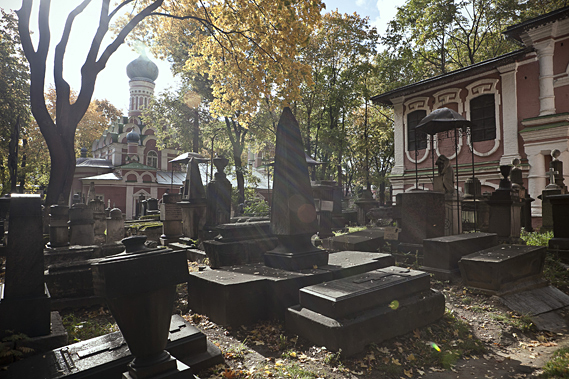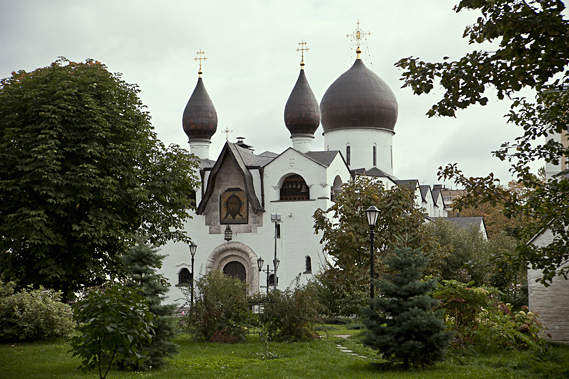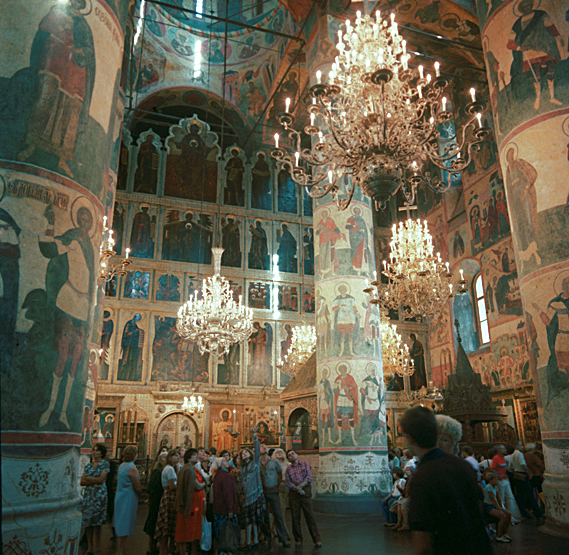BEST OF MOSCOW


The most delicious khinkali, the most breath-taking city view, the most unexpected golf club right in the center of Moscow, unrevealed little-known museums, exceptional buildings and lots of other places you won’t find in Lonely Planet guides or Rough Guide and Dorling Kindersley. To help moscovites and Moscow guests to find their way in the city Bolshoy Gorod magazine created guide to Moscow. The selection, based on our taste, includes best churches, places to have a nice stroll, entertainment spots, shops and bars/restaurants
- 26 Октября 2011
- 10 мин
- 1077226

Photo: Mark Boyarsky
This monastery shelters the most ancient (15th century) church in Moscow (outside the Kremlin), the Savior Cathedral. Aside from the church`s beauty, the key point is that its walls still carry fragments of frescoes painted by Andrey Rublyov, a legendary icon painter and a monk who lived and died within the walls of the monastery. Also, the Museum of Ancient Russian Art and Culture, with its 13th—17th century icon collection, has operated on the territory of the monastery since 1960. The Savior Cathedral is a working church again. From the monastery`s location on the high bank of the Yauza River, one can enjoy wonderful views, making it a pleasant place for a stroll.
Address: 10, Andronievskaya sq.

Photo: Mark Boyarsky
Of all the rich history this monastery has to offer, the tombstones in its vast graveyard hold the greatest attraction for the idle mind. For hundreds of years the graveyard served as the last refuge for members of aristocratic families such as Viazemsky, Trubetskoy and Dolgoruky. Odoevsky, Kliuchevsky, Karamzin and other prominent writers and scholars were also buried here. A number of graves appeared more recently. The new arrivals are reburials, and include the necropolis` oldest relic, the 14th century tombstone of the boyar Fiodor Biakont, and others of the White Guard generals Semionov, Krasnov and Shkuro. In 2005, General Denikin`s ashes were also brought here. Some of the tombstones are quite odd-looking; for instance, those of Freemasons.
Address: 1, Donskaya sq.

Photo: RIA Novosti
The territory of this convent is one of the best places in town for taking a walk, both within the walls in its beautiful gardens and outside around the pond. There are no hassles here, not a single kiosk or stall. People leisurely stroll along the paths of the park — some with prams, some without — and children feed ducks at the pond. There is even a monument to the ducks. Sunset is the best time for a walk.
It`s quite amusing to read requests addressed to Princess Sofia on the monastery`s Sofia Tower: "Sophia, help me get my husband back," "Sophiushka, help me with my dissertation."
Address: 1, Novodevichy Proezd

Photo: Mark Boyarsky
Built in 1913 by Alexey Schusev and sponsored by Grand Duchess Elisaveta Feodorovna, this cathedral at the Convent of Martha and Maria deserves to be considered one of Moscow`s most amazing. It`s done in Neo-Russian Style, with some references to the medieval styles of Novgorod and Pskov as well as the Art Nouveau of the 20th century. Ancient Russian ornamentation and carved vestibules are juxtaposed with depictions of absolutely modern-looking angels, all giving a refreshingly contemporary appearance to the cathedral. Schusev, a famous Russian and Soviet architect, also designed the Kazansky Railway Station and Lenin`s Mausoleum.
Address: 34, Bolshaya Ordynka st.

Photo: Mark Boyarsky
The Purification Stauropegial Monastery, founded in the 14th century, is governed by the archimandrite Tikhon Shevkunov. The monastery is the center of almost all conceivable church activities. It has the country`s biggest Russian Orthodox publishing house, a huge bookstore, a seminary, the editorial office of the website www.pravoslavie.ru and even the Center for the Study of the Holy Turin Shroud (whose full-size replica hangs in the monastery`s church). For a secular person, this monastery is interesting for two reasons. First, it has an incredible men`s choir. Second, its territory is surprisingly green: Grapevines spill over the wall to the street, hydrangeas grow in the garden, and rose bushes, birch trees and thuyas flank paths that pass by a beautiful manmade pond.
Address: 19, Bolshaya Lubyanka, st. 1
Photo: ITAR-TASS
Perhaps the most beautiful of the Kremlin`s cathedrals, the Assumption was used for major state ceremonies before the revolution. It was designed in 1475-1479 by the Italian architect Aristotele Fioravanti on the model of the Assumption Cathedral in Vladimir. The legendary icon painter Dionisiy and his group took part in painting murals here. While the walls were repainted in the 17th century, some of Dionisiy`s murals survived (see depictions of the saints on the altar partition). An icon depicting the Moscow Metropolitan Alexiy`s life is also attributed to the brush of Dionisiy, as well as a few other icons saved from the previous Assumption Cathedral, on whose site the present one was built. The rest of the frescoes covering the cathedral from floor to ceiling are also worth the wait to buy tickets at the Kremlin box-office.
Address: Kremlin
- 26 Октября 2011
- 1077226
- 10 мин
- Вверх










